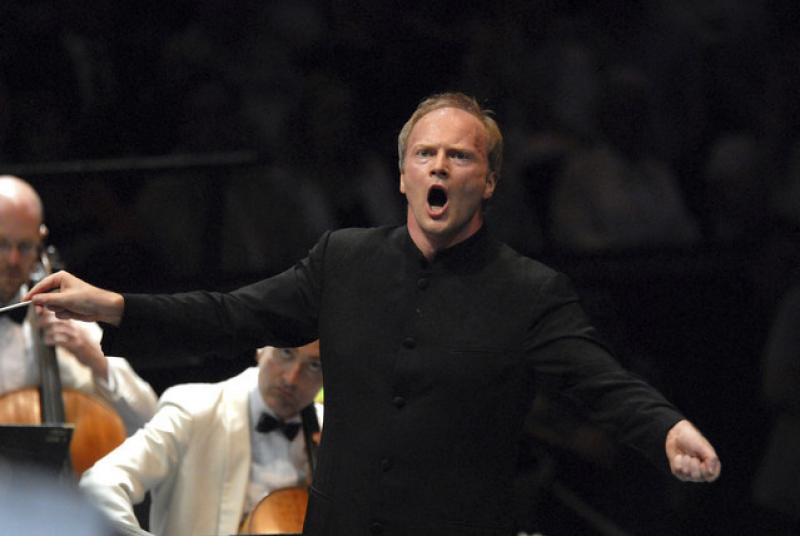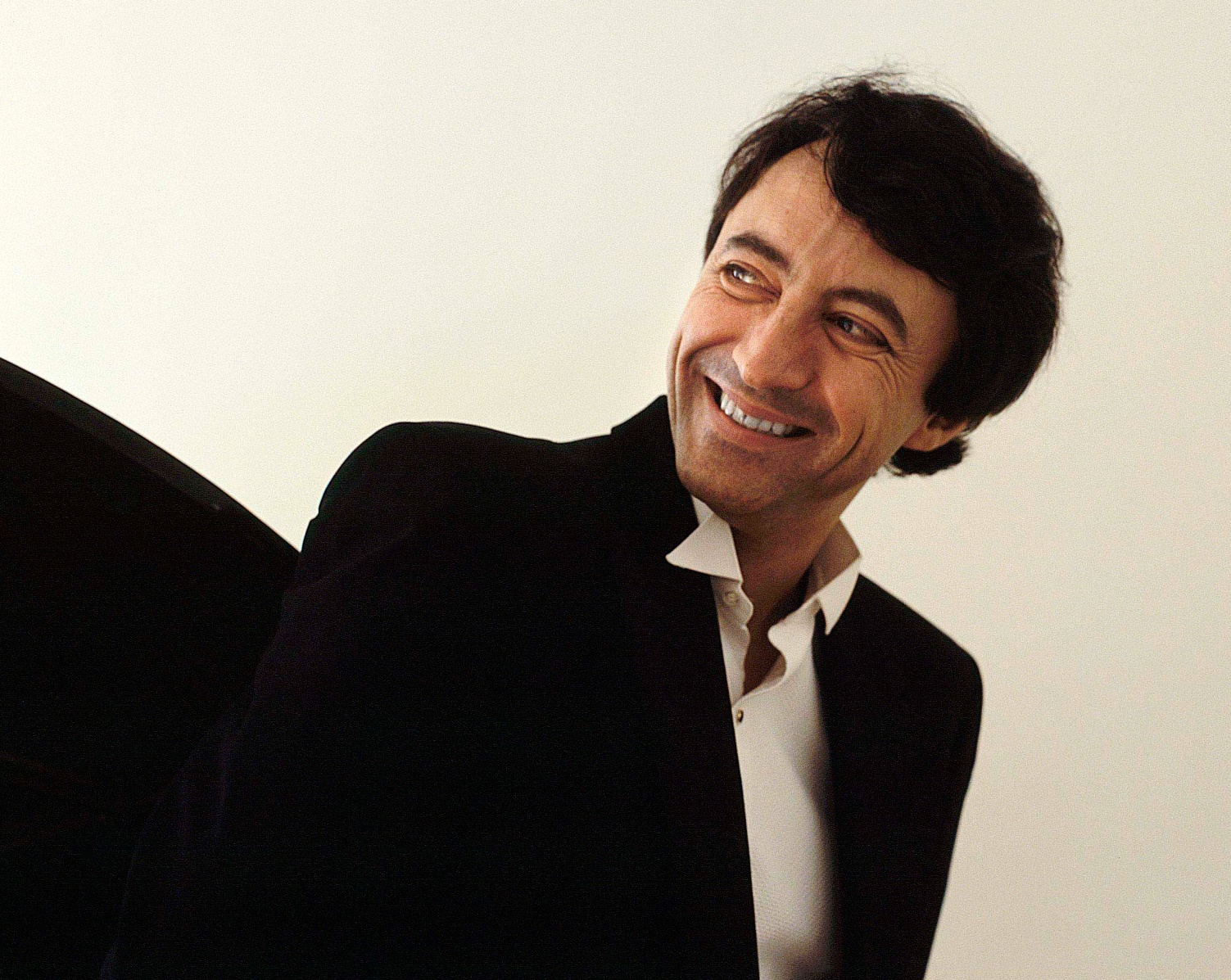Prom 30: Bavouzet, BBC Philharmonic, Noseda | reviews, news & interviews
Prom 30: Bavouzet, BBC Philharmonic, Noseda
Prom 30: Bavouzet, BBC Philharmonic, Noseda
Russians dance at the Italian conductor's command, but is there any place for an invertebrate BBC commission?

It was mostly Russian night at the Proms, and mostly music you could dance to, as a hand jiving Arena Prommer rather distractingly proved in the finale of Tchaikovsky’s Second Symphony. Even Prokofiev’s elephantine Second Piano Concerto was transformed into the ballet music Serge Diaghilev thought it might become in 1914. Much of this was thanks to the fleet feet and mobile shoulders of febrile BBC Philharmonic conductor Gianandrea Noseda.
One blunt question has to be asked: why a BBC commission for a composer whose music, however connected he says it is with science and visual art, has hardly touched a wide public across nearly 40 years? Partly because it’s Cowie’s 70th birthday. But if this had been the result of a young composer’s chance, we’d still be questioning the corporation’s judgment.
We had eight unforgettable song and dance themes in 25 minutes
The first of Cowie’s Earth Music canvases, The Great Barrier Reef, impresses only in its brevity. The composer comes across as arrogant when he tells us in the programme note that this is a piece of "great energy and timbral richness". The timbres, chords and sea-splashes, atmosphere in search of foreground ideas, seemed to me curiously unoriginal until the earcatching last few bars of calm, the large percussion array engaged until then with a far from discriminating ear. As for "great energy", doesn’t it usually come from the firm rhythmic backbone which this invertebrate lacked, and which was so apparent in the three other works?
Noseda cannily kicked off with not just the Overture from Borodin’s Prince Igor but also its Polovtsian Dances minus chorus, both owing their special vitality to more than a little help from Glazunov and Rimsky-Korsakov. The sequence meant that we had eight unforgettable song and dance themes in 25 minutes. Just as in the previous evening’s Overture and Venusberg Music of Wagner’s Tannhäuser, we first heard the noble – in this case a widescreen picture of old Russia – and moved on to exoticism, which with Borodin means depiction of the eastern tribe about whom, unlike Wagner with Venus's sexy realm, he was so unjudgmental. Noseda shoulder-shrugged the overture’s vigour and bounced the more pungent dances into vivid life, but gave plenty of time to Igor’s aria melody, coolly sung by first horn Andrew Budden, and the wistful undulations of the Polovtsian women.
 The conductor’s spring-heeled manner found a perfect mate for Prokofiev's killer concerto in the mercurial shape of Jean-Efflam Bavouzet (pictured right by Guy Vivien), a surprise interpreter better known for his gleaming Ravel and Debussy. This was the perfect antithesis to heavier, fast-vanishing performances from the likes of Gergiev and the heavy-footed Falstaff at his court Alexander Toradze.
The conductor’s spring-heeled manner found a perfect mate for Prokofiev's killer concerto in the mercurial shape of Jean-Efflam Bavouzet (pictured right by Guy Vivien), a surprise interpreter better known for his gleaming Ravel and Debussy. This was the perfect antithesis to heavier, fast-vanishing performances from the likes of Gergiev and the heavy-footed Falstaff at his court Alexander Toradze.
Having started with crystalline brightness in right-hand octaves, Bavouzet hit a galaxy of wrong notes in Prokofiev’s outlandish first-movement cadenza, but he did it with such style that you believed in it. The scherzo flashed past with greater velocity and nimbleness than I’ve ever heard before, while the cavalcade of third-movement monsters found Noseda and Bavouzet playing naughty boys rather than carnivorous dinosaurs.There was poetry at just the right point in the rather prolix finale. What a shame Bavouzet couldn’t have given us a cooling Debussy etude as an encore.
Tchaikovsky’s patronizingly nicknamed “Little Russian” Symphony – the alien subtitle sticks - could only charm us with its rhythmic vivacity after Cowie’s jellyfish. A little poker-faced in the first movement’s fusion of folksong and Beethoven, and over-brittle in the miniature march Tchaikovsky uses to replace the expected slow movement, Noseda’s players dazzled in the last two movements, culminating in a ferociously articulate account of the finale’s variations on a Ukrainian folk song. The last delicious joke was how the merrymaking danced out unhindered from under the heels of the severe tam-tam, prince among Tchaikovsky's demons of opposition, and whirled their way to an irrepressible victory tattoo.
rating
Share this article
Add comment
The future of Arts Journalism
You can stop theartsdesk.com closing!
We urgently need financing to survive. Our fundraising drive has thus far raised £49,000 but we need to reach £100,000 or we will be forced to close. Please contribute here: https://gofund.me/c3f6033d
And if you can forward this information to anyone who might assist, we’d be grateful.

Subscribe to theartsdesk.com
Thank you for continuing to read our work on theartsdesk.com. For unlimited access to every article in its entirety, including our archive of more than 15,000 pieces, we're asking for £5 per month or £40 per year. We feel it's a very good deal, and hope you do too.
To take a subscription now simply click here.
And if you're looking for that extra gift for a friend or family member, why not treat them to a theartsdesk.com gift subscription?
more Classical music
 Kolesnikov, Tsoy / Liu, NCPA Orchestra, Chung, Edinburgh International Festival 2025 review - transfigured playing and heavenly desire
Three star pianists work wonders, and an orchestra dazzles, at least on the surface
Kolesnikov, Tsoy / Liu, NCPA Orchestra, Chung, Edinburgh International Festival 2025 review - transfigured playing and heavenly desire
Three star pianists work wonders, and an orchestra dazzles, at least on the surface
 BBC Proms: Láng, Cser, Budapest Festival Orchestra, Ivan Fischer review - idiomatic inflections
Bartók’s heart of darkness follows Beethoven’s dancing light
BBC Proms: Láng, Cser, Budapest Festival Orchestra, Ivan Fischer review - idiomatic inflections
Bartók’s heart of darkness follows Beethoven’s dancing light
 Weilerstein, NYO2, Payare / Dueñas, Malofeev, Edinburgh International Festival 2025 review - youthful energy and emotional intensity
Big-boned Prokofiev and Shostakovich, cacophonous López, plus intense violin/piano duo
Weilerstein, NYO2, Payare / Dueñas, Malofeev, Edinburgh International Festival 2025 review - youthful energy and emotional intensity
Big-boned Prokofiev and Shostakovich, cacophonous López, plus intense violin/piano duo
 theartsdesk at the Three Choirs Festival - Passion in the Cathedral
Cantatas new and old, slate quarries to Calvary
theartsdesk at the Three Choirs Festival - Passion in the Cathedral
Cantatas new and old, slate quarries to Calvary
 BBC Proms: Estonian Philharmonic Chamber Choir, Kaljuste review - Arvo Pärt 90th birthday tribute
Stillness and contemplation characterise this well sung late-nighter
BBC Proms: Estonian Philharmonic Chamber Choir, Kaljuste review - Arvo Pärt 90th birthday tribute
Stillness and contemplation characterise this well sung late-nighter
 BBC Proms: Kholodenko, BBCNOW, Otaka review - exhilarating Lutosławski, underwhelming Rachmaninov
Polish composers to the fore in veteran conductor’s farewell
BBC Proms: Kholodenko, BBCNOW, Otaka review - exhilarating Lutosławski, underwhelming Rachmaninov
Polish composers to the fore in veteran conductor’s farewell
 theartsdesk at the Pärnu Music Festival 2025 - Arvo Pärt at 90 flanked by lightness and warmth
Paavo Järvi’s Estonian Festival Orchestra still casts its familiar spell
theartsdesk at the Pärnu Music Festival 2025 - Arvo Pärt at 90 flanked by lightness and warmth
Paavo Järvi’s Estonian Festival Orchestra still casts its familiar spell
 BBC Proms: Batsashvili, BBC Scottish Symphony Orchestra, Ryan Wigglesworth review - grief and glory
Subdued Mozart yields to blazing Bruckner
BBC Proms: Batsashvili, BBC Scottish Symphony Orchestra, Ryan Wigglesworth review - grief and glory
Subdued Mozart yields to blazing Bruckner
 Classical CDs: Hens, Hamburg and handmaids
An unsung French conductor boxed up, plus Argentinian string quartets and baroque keyboard music
Classical CDs: Hens, Hamburg and handmaids
An unsung French conductor boxed up, plus Argentinian string quartets and baroque keyboard music
 BBC Proms: McCarthy, Bournemouth SO, Wigglesworth review - spring-heeled variety
A Ravel concerto and a Walton symphony with depth but huge entertainment value
BBC Proms: McCarthy, Bournemouth SO, Wigglesworth review - spring-heeled variety
A Ravel concerto and a Walton symphony with depth but huge entertainment value
 BBC Proms: First Night, Batiashvili, BBCSO, Oramo review - glorious Vaughan Williams
Spirited festival opener is crowned with little-heard choral epic
BBC Proms: First Night, Batiashvili, BBCSO, Oramo review - glorious Vaughan Williams
Spirited festival opener is crowned with little-heard choral epic
 Interview: Quinteto Astor Piazzolla on playing in London and why Mick Jagger's a fan
Music Director Julián Vat and pianist Matias Feigin compare notes on Piazzolla
Interview: Quinteto Astor Piazzolla on playing in London and why Mick Jagger's a fan
Music Director Julián Vat and pianist Matias Feigin compare notes on Piazzolla

Comments
Good gracious, I only tuned
You may be right about the
You may be right about the many heavy passages, Viktor, and from my seat to the right - not a good place for either first violins or cellos, facing away - I was making some allowances for the strange sound, but don't you think there was some poetry and a great deal of interesting musicianship? Bavouzet would never be in my top five for this impossible piece, but it was at least an interesting take full of personality.
Your reviewer (hardly the
Unwise comment on David
You are probably right, I too
You misunderstood me, Mr.
You misunderstood me, Mr. Cowie. When I wrote, however presumptuously, that I thought your music had "hardly touched a wide public" over 40 years, I meant to imply that I wasn't sure it had communicated (I was well aware of your first Proms commission in 1975, as that implies).
Believe it or not, I respect your interdisciplinary approach and would even like to know more about it. What worries me is that the intentions and the obvious skill in craftsmanship may not translate into a result that reaches out to a large audience. This is a thorny question, how much a composer adapts his or her style to acknowledge that a large-scale orchestral commission reflects, or in my opinion should reflect, not just the taste of the commissioners but the immediate impact on a wide range of listeners.
As for the question of rhythm, I don't doubt it is there - but without playing a foreground role, how is it to be perceived by the audience?
Far too late in responding,